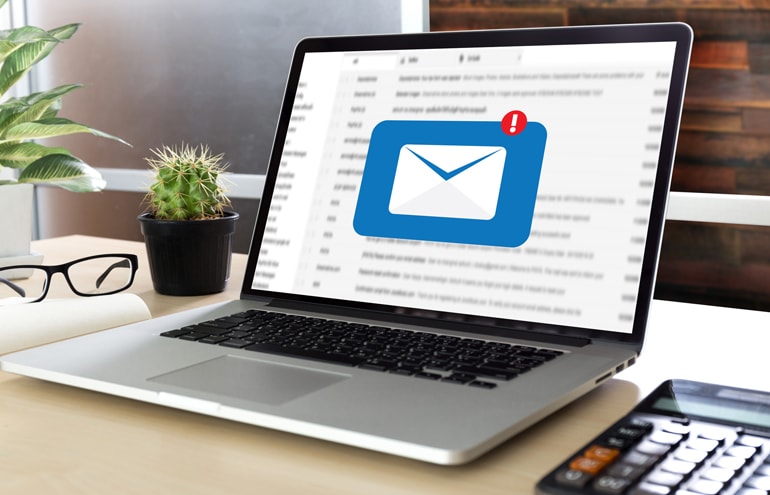To make my inbox more manageable, I had to change my ways and find new habits. 10 habits to help conquer your email communication.

Table of contents
It had complete control of me. With the convenience of my smartphone, I was tethered to my inbox day and night. It was the first thing I looked at in the morning and the last thing I checked before bed. Not only was this not necessary, but it was not efficient or even healthy. I needed help controlling my email communications habits. Sound familiar?
Email is the grand champion of modern-day communication, at least in the professional realm. So to make my inbox more manageable, I had to change my ways and find new habits. Once I did, the efficiency and effectiveness of my email communications improved my operations inside my organization and with outside stakeholders.
Below are 10 habits you can cultivate to help conquer your email communications.
Reconsider the Use of “Reply All”
Ask yourself if your email response needs to go to everyone included in the original message. Even if the information you’re providing is relevant, is it necessary to send it to every person?
Thinking of your email blast as a mini-meeting can give it context. If you hold a brief, 10-minute meeting with eight team members, that meeting does not cost you 10minutes. It costs your organization 10 x 8 = 80 minutes. Was it necessary to have every person copied, or will a single reply to the sender, or a forward to a single recipient, suffice?
When in doubt, just use Reply. Or at least use the To field for the intended recipient and the Cc field for those you want to inform of the content — in other words, an FYI.
Lastly, when you choose to send a Reply All email, take a moment to confirm which email addresses are in which field and drag and drop the emails to their appropriate spots before sending.
To vs. Cc
So, let’s talk about the proper use of the To and Cc fields and whose email address should go into each.
To: It’s simply the email address of the person you’re contacting and possibly of someone requesting a follow-up action.
Cc: Three main reasons you might Cc someone are (1) to provide the content of the email for their information only, while not inferring a reply or action is needed; (2) to introduce or connect the copied person with the primary recipient; and (3) to inform the primary recipient that the copied person if being informed of this communication.
Remember that any Cc’ed email is openly visible to all To and Cc recipients, so you should consider any privacy concerns of each contact you’re adding. Just like giving out a phone number or address, everyone on that email now has access to that email address.
What’s in a Name (or Email Address)?
Before we move on to the infamous Bcc, let’s pause to remember that not all email addresses are created equal. Many professional email addresses already contain all or part of the person’s name as part of the actual email, such as mine: mark.palmer@2civility.org. In these cases, you immediately know who you are likely contacting and at what organization by a well-constructed email address.
In other cases, not so much: contact@example.gov or jim@megalawfirm.legal. Huh?
So, practice better email etiquette by including names, called sender info, or display names, along with the email address. By adding each email owner’s name before the email address, the other recipients can better identify who is on the communication, e.g., James B. Dean <jim@megalawfirm.legal>.
Even though you correctly enter “Name <email address>” in the email field, the email program may automatically hide the email address, displaying only the name. That’s fine. You might need to hover over or double-click the name to see the actual email address associated with the name.
Lastly, if you use auto-complete in the addressee fields, be sure that you are sending it to the correct person and the correct email for that person. For example, if you’re sending a business email to a group and a recipient is also your friend for whom you have both their business and personal emails in your contacts, be mindful not to send that contract for review to hockeymom6789@gmail.com.
Be Careful With Bcc
Generally, Bcc allows you to email one or many without the recipients seeing who is included on the email. This can be useful when, for example, emailing a group of people without exposing their email addresses or creating an unwanted ability for them to Reply All instead of replying to the sender alone.
While the use of Bcc to secretly share emails by blind-copying a party (e.g., your client) may seem an efficient way to keep them fully informed with full transparency, it is NOT the best practice to do so, or even the ethical way to do so.
Lawyers have a duty to communicate with their clients and keep them reasonably informed about their matters under Model Rule 1.4. You might be inclined to keep a client informed about communications between you and the opposing lawyer by Bcc’ing them on all correspondence. Yet as several ethical opinions have examined, this practice may create potential confidentiality and privilege issues.
Think of the situation when blind-copying a client leads to the client using Reply All instead of Reply to send the client’s response (opinions, wishes, confidential information, etc.) to the court and opposing parties, showing what was clearly intended only for the client’s lawyer. This situation (actually found in the 2010 Massachusetts case Charm v. Kohn (Mass. Super. Sept. 30, 2010)) could have been avoided had the client’s attorney forwarded the sent email to the client as a new email instead of using Bcc. Then, any reply by the client would only have gone to the lawyer.
For more ethical discussion, see these various opinions:
- Alaska Bar Association Ethics Opinion 2018-01
- Florida Bar Ethics Opinion 76-21
- Illinois State Bar Association Advisory Opinion 19-05
- Kentucky Bar Association Ethics Opinion KBA E-442 (2017)
- New York City Bar Association Formal Opinion 2009-1
- New York State Bar Association Ethics Opinion 1076
- North Carolina State Bar 2012 Formal Ethics Opinion 7
- Pennsylvania Bar Association Formal Ethical Opinion 2020-100
- South Carolina Bar Advisory Opinion 18-04
Forward With Courtesy
Ever get a 12-page email thread forwarded to you without any content from the sender? If you have an instance when you wish to share a communication with another by forwarding on an email, take a moment to kindly summarize the message, provide context, request next steps, or otherwise provide a brief, clear message as to the purpose of your sharing the content.
Sure, an “FYI” may be appropriate at times, if it truly is only for the recipient’s information without any further consideration or action. Whereas “see below” or a blank email lacks any direction.
New Topic? New Email Thread
Emails are not an open line of communication. Don’t be tempted to use an existing email thread to cover a new topic or ask an unrelated question. We automatically equate the email topic with what is, and has been, the email thread’s subject line, so anything sent off-topic is very likely to get overlooked.
Instead, start new email threads for new topics using a new email message.
Your Signature Block
Two critical takeaways regarding your email signature blocks are their content and when to use them. They should be concise and straightforward while being accessible to the recipients when and how they might need them.
You’ll at least want your name, title, organization name and contact information in a business signature. You may wish to provide your Twitter handle or preferred pronouns. If you use a logo or other graphic, keep it small and straightforward as well.
As for when to use them, I suggest including your full business signature at the onset of each email or initial reply. You may subsequently only conclude with an abbreviated signature line of your name or even initials, if appropriate, to improve the email thread’s flow and readability while still giving clear context as to who is saying what.
Lastly, a note for lawyers regarding the template “disclaimers” we love to use at the end of emails, often regardless of the email’s content or audience. Take the time to create various email signatures for varying communication types and examine the language you have included. For example, the IRS finalized a rulemaking process that rendered the Circular 230 disclaimer obsolete (back in 2014); and it has been asking practitioners to remove the “Circular 230 language” from email footers ever since.
Reply to ALL Emails Promptly
The leading piece of advice I received as a new lawyer from our firm’s senior partner was that we always respond to messages. Always! At the time, he was more talking about phone messages than the email variety, yet the customer service lesson was never lost on me.
A timely response to clients (past, present and future), vendors, media, co-workers and anyone else awaiting a reply is a hallmark of the service industry. We all have overflowing inboxes and busy schedules, so don’t take this advice to mean you must immediately fire off a response.
- Co-workers. In general, try to get back to co-workers within 12 to 24 hours. If you cannot respond, let them know you’ve read their email, and will follow-up by a time that works for them.
- Clients and colleagues. For external communication and unless urgent, replying within the same business week is appropriate. The key remains to keep the communication channel flowing. Even a quick reply of, “Thanks for your email. I’ll have a response for you by Friday,” shows the client you are responsive and you care.
- Prospects. When it comes to responding to potential clients, the most important factor is responsiveness, according to the 2019 Legal Trends Report. Responding to an initial inquiry beyond 24 hours means you’re not meeting the expectations of 79% of those leaving a message. Given that most potential clients continue their search to other firms, it’s likely your missed connection cost you more than a missed first impression.
Lastly, sometimes we receive an email not intended for us (e.g., here and here). Lawyers have an ethical obligation to do more than just hit delete and “promptly notify the sender” under Model Rule 4.4(b). A sample reply could be: “As this message was sent to me in error (to [email address]), I am giving you notice of such under Illinois Rules of Professional Conduct Rule 4.4(b), and will now delete the original. Please update your contacts accordingly.”
Promptly Doesn’t Always Mean Immediately
One of the toughest habits to break is constantly checking and replying to emails as they hit your inbox. Think if you walked out to your mailbox 84 times a day, how inefficient that would be. Yet, we are held hostage by email notifications on our computers and mobile devices.
There are a couple of options to work on curbing this bad habit.
- Try to schedule “email time” on your calendar and keep to it. Maybe three or four times a day, or maybe even less if you have to concentrate on an important project. Setting aside specific times helps keep yourself accountable and better focused on your other tasks.
- Try working in focused sprints — monotasking without any distractions for 25 minutes at a time with a five-minute break. Repeat four times before taking a 20-30 minute break. This method, known as the Pomodoro Technique, helps you allocate your time better and improve the quality of your outputs with far fewer distractions.
- There are even apps to help you achieve this, such as the BFT app (Bear Focus Timer), which uses a “friendly but firm” bear to keep you from touching your phone.
Lastly, I must give a caveat that there are times when sooner is better for email replies, such as those VIP clients or those potential client inquiries. Again, this is where you can use technology to build processes to have expedited replies or personalized attention to intake communications.
Out of Office Scheduling
When you are unavailable to give the courtesy of a reply, why not have technology do it for you? Here are the guidelines I recommend when setting an out of office notification (OOO):
DO:
- Keep the message simple: Quickly convey when you will return and, if necessary, the contact information for whom to contact for urgent matters.
- Consider limiting your OOO to auto-replying only to those inside your organization and possibly outside recipients who are already in your contacts.
- Schedule the exact time-period you want the OOO active. This helps it start when you want (e.g., 5 p.m. on the last day of work) and automatically turn back off (e.g., 5 p.m. the day before you return). You don’t want to be back to work a day or two before a client emails you to say your OOO is still on.
DON’T:
- Include a colleague to contact without letting that colleague know you’ve done so.
- Include personal details in your OOO, e.g., “Off to canoe in the Boundary Waters for a week with the whole family!” It’s poor form and gives the world notice that your home will be unoccupied.
- Set an OOO for significant holidays when most everyone is going to be away as well.
- Forget to check with your listed colleague upon return for a debrief and any matters that still need your attention.
While communication is the bridge between confusion and clarity, how you build and operate that bridge will determine how well information can travel upon it.
Hopefully, utilizing these habits can help you create better patterns to maintain an efficient and effective inbox on your way to excellent communication inside and outside your organization.
About the Illinois Supreme Court Commission on Professionalism
The Commission on Professionalism was established by the Illinois Supreme Court in September 2005 to foster increased civility, professionalism and inclusiveness among lawyers and judges in the state of Illinois. By advancing the highest standards of conduct among lawyers, we work to better serve clients and society alike. These duties we uphold are defined under Supreme Court Rule 799(c). For more information, visit 2Civility.org.
Illustration ©iStockPhoto.com
More Good Ideas from Attorney at Work
Subscribe to the Daily Dispatch and Weekly Wrap (it’s free) and follow us on Twitter @attnyatwork.
You Might Also Like …
















